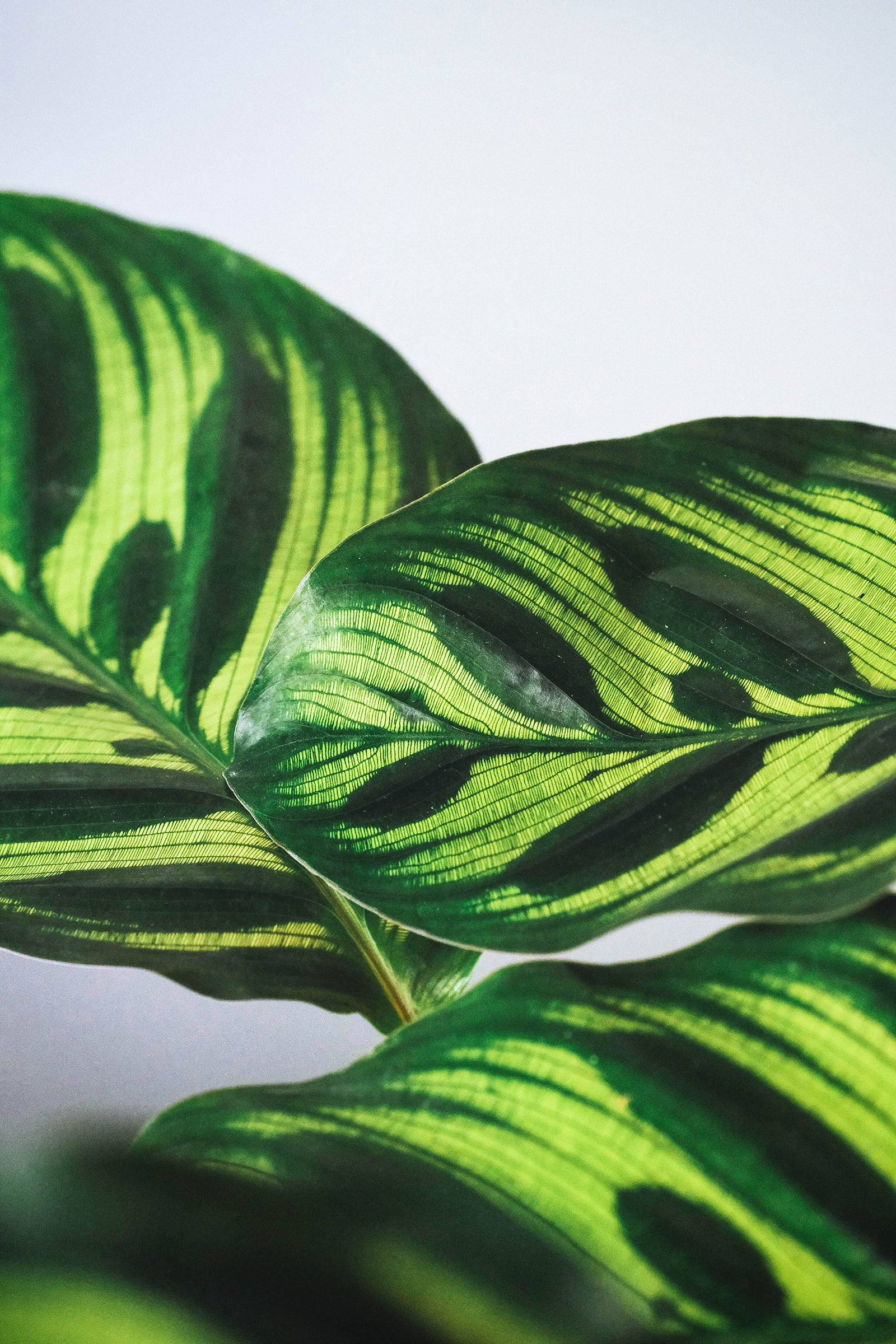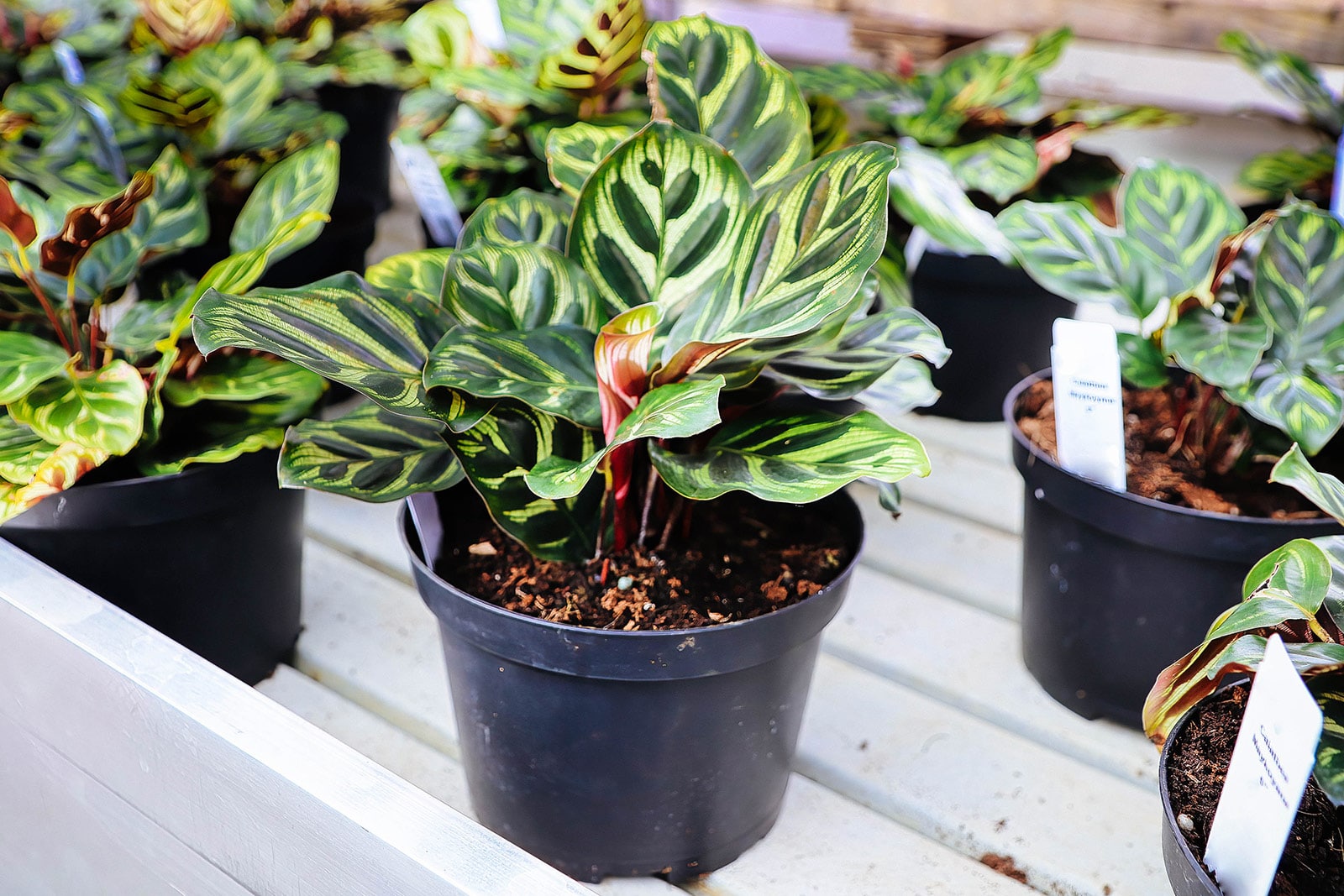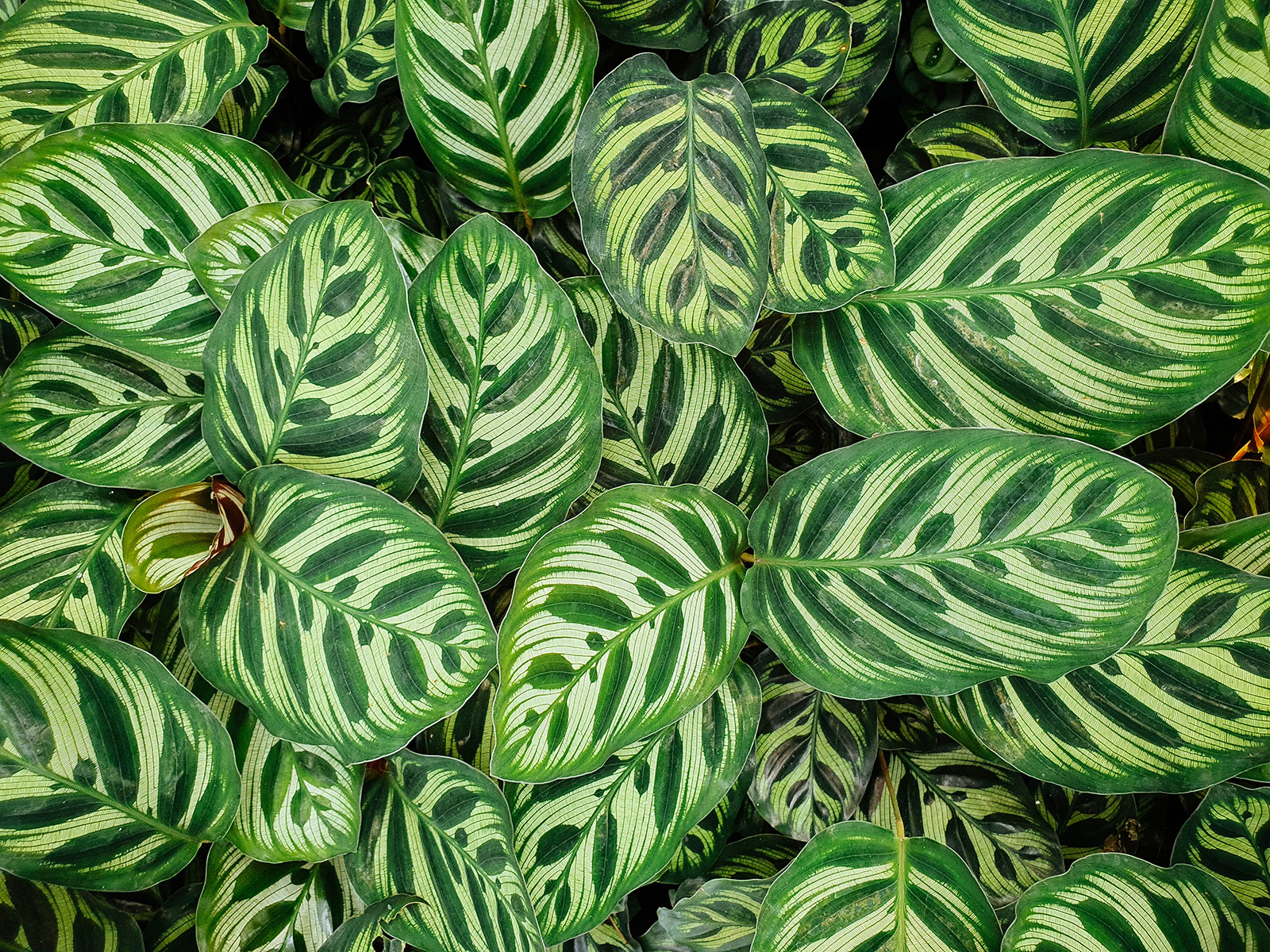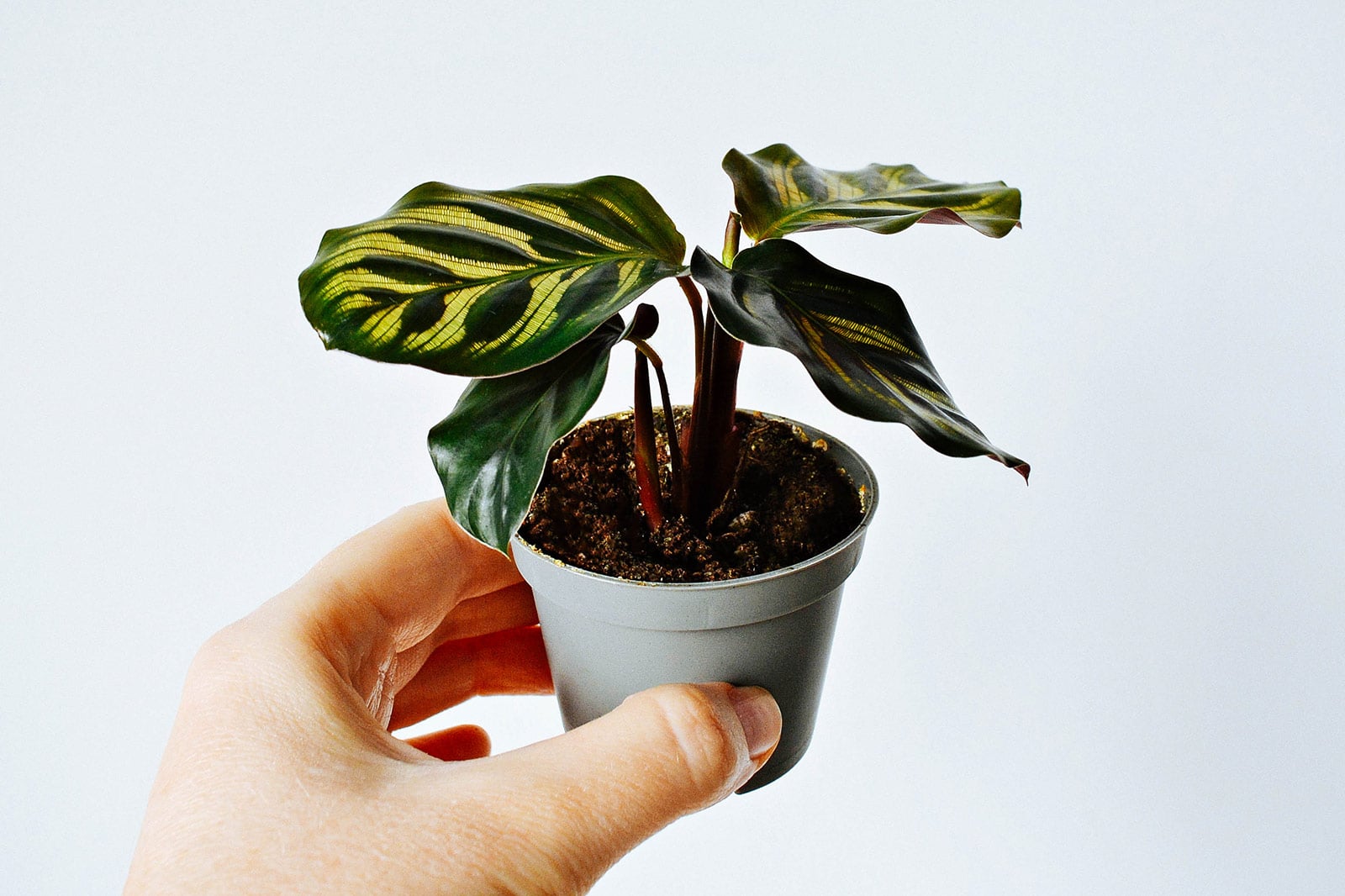If you’re looking for a houseplant that can add a bit of wow factor to your home, I’ve got just the one for you. Prayer plants are among the most spectacular indoor plants you’ll find in your local garden center, and Calathea makoyana (the peacock prayer plant) is no exception. With its regal look comes a diva attitude, but with the right care, you should absolutely be able to grow a thriving peacock plant in your home!
Keep reading for everything you need to know about Calathea makoyana care and how to grow this prayer plant in your own home.
| Common name(s) | Peacock plant, peacock Calathea, cathedral Calathea or cathedral windows, prayer plant |
| Scientific name | Goeppertia makoyana, formerly Calathea makoyana |
| Family | Marantaceae |
| Height and spread | Up to 3 feet high and 2 feet wide |
| Light | Bright indirect light |
| Soil type | Rich but well-draining |
| Water | Keep lightly moist |
Disclosure: If you shop from my article or make a purchase through one of my links, I may receive commissions on some of the products I recommend.

About Calathea makoyana
Natural habitat
Members of the family Marantaceae, of which the peacock prayer plant is a part, are neotropical: They’re naturally found in South America. Although they’re spread among a range of countries, Brazil holds the undisputed record for prayer plant presence. Calathea makoyana, specifically, naturally occurs in the Brazilian state of Espírito Santo.
I couldn’t find any specific habitat descriptions, but it’s not difficult to assume what it would look like. Calatheas are rainforest plants, forming part of the darker, warm and humid undergrowth. It’s a good idea to keep this in mind if you’d like to grow one in your home! You’ll have to imitate these jungle conditions as best as you can if you’d like your peacock prayer plant to thrive.
Description
In an 1883 horticultural review by the director of the botanical garden in Liège (Belgium), Charles Morren, the author, described the new plant he found in one of his horticulturists’ greenhouses as “most beautiful and most remarkable.” Over 130 years later, I think his point still stands!
Calathea makoyana is an evergreen perennial that sports large, oval leaves on long, thin stems. These leaves sprout from a central rhizome and feature dark green blotches on a lighter green base.
They really do remind me of peacock feathers, which explains how this prayer plant got its common name. The backs of the delicate, almost papery leaves are reddish-pink in color and look beautiful when the light shines through them.
Similar to other prayer plants (and to Oxalis triangularis, another nyctinastic plant), Calathea makoyana folds its leaves up at night in “prayer,” a natural trait that isn’t fully understood yet.
Where to buy
Calathea vs. Goeppertia: the mass reclassification
In his 1883 text, Charles Morren remarked that the plant he described “seemed to them a proper species,” and that it was named after the horticulturist who had it in his greenhouse, one Jacob-Makoy. He categorized it in the genus Calathea.
Unfortunately, as with a bunch of other prayer plants, this initial naming brought with it some taxonomical trouble that emerged more than 100 years later. You may have noticed that the table above lists the scientific name of this plant as Goeppertia, not Calathea, even though everyone calls it a Calathea (and you’re likely to find it labeled as a Calathea in plant shops). What’s up with that?
Basically, taxonomic changes happen all the time in plants. For example, Epipremnum aureum (pothos) used to be Epipremnum pinnatum and a slew of other names. There’s also the recent reclassification of rosemary—the herb you know and love as Rosmarinus officinalis—to Salvia, as in sage.
As molecular and DNA research improve, it’s often discovered that certain species should be restructured, new genera should be created, and other species are really not even species at all. This happened to Calathea as well. A 2012 study showed that not all of the plants that had previously been placed in this genus really belonged there.
Based on this study, the genus Calathea was decimated pretty severely! An old genus called Goeppertia that they had lying around was resurrected and loads of Calatheas were moved into it, including Calathea orbifolia (now Goeppertia orbifolia), Calathea ornata (now Goeppertia ornata), and today’s subject, Calathea makoyana (now Goeppertia makoyana).
The thing is that in the houseplant hobby, these changes are usually very slow to take hold. We’ve all known this plant as a Calathea for as long as we can remember, and for many people, it’s going to stay that way. That’s why I’m still referring to it as such in this article.
It’s similar to what happened with the popular succulent Sansevieria: much of the genus got recategorized into Dracaena, but to indoor gardeners, a Sansevieria will probably always be a Sansevieria.

Caring for Calathea makoyana
Light and temperature
Like most of the other tropical houseplants we indoor gardeners are so fond of, Calathea makoyana prefers bright indirect light. It hasn’t evolved to withstand strong direct sun and its thin leaves burn easily, especially without proper acclimation. An example of the kind of bright indirect light that a peacock plant appreciates would be in a north-facing window (in the Northern Hemisphere).
As for temperature, here too we need to keep the species’ tropical origins in mind. These guys really don’t like the cold. Although they can survive temperatures as low as around 59°F, at these temps, your plant will more than likely stop growing. It’s better to keep things around room temperature, although warmer isn’t a problem either for this species. They’re used to being pretty toasty in those Brazilian jungles.
Water and humidity
The most important thing to remember when it comes to prayer plants and water is that they love moisture, but they definitely don’t love being drowned. One of the reasons many houseplant enthusiasts find them difficult to grow is that it can be challenging to find the right balance for their plants, especially considering the fact that this species can also be sensitive to tap water.
That last bit can be remedied by regularly flushing your Calathea makoyana’s soil with distilled water, but how do you know when it’s time to give your plant a drink?
It’s best not to water on a schedule, as the amount and frequency depend on factors like the season, light, and soil. Instead, remember that the plant should be kept lightly moist; you can gauge the moisture level by using a moisture meter like this one, visually assessing the soil, or just doing the ol’ finger test. Let it dry out a little more in winter and increase moisture levels somewhat during the active summer growing months.
Also make sure you keep a close eye on the humidity in your home. The rainforests that peacock plants naturally occur in are at 100 percent humidity for much of the time, so it’s no surprise these plants don’t always fare well in our dry homes (especially in winter with our furnaces and fireplaces).
Group plants together and use a humidifier to try to get levels to at least 50 percent if you notice your Calathea’s leaves starting to show excessive brown tips. (A simple digital hygrometer can tell you when the relative humidity in your home is too low. I use and recommend this one.)
Soil and planting
The soil you plant your peacock Calathea in should reflect both the plant’s love for water and dislike of getting soaked. You can easily mix your own prayer plant soil.
There are loads of recipes, but my favorite easy blend is two parts regular houseplant potting soil, one part sphagnum moss or coco coir, and one part perlite. The moss/coir holds some moisture, but not too much. The perlite, on the other end, keeps things airy and allows excess water to flow away freely.
Now, it wouldn’t be helpful to mix this well-draining soil if excess water has nowhere to go once it reaches the bottom of the planter. That’s why you should always use a container with a drainage hole! Go for a standard plastic nursery pot inside a decorative overpot, for example, or use a planter with a hole (and a saucer, to prevent staining your windowsills).
Recommended products for Calathea makoyana plant care:
- FoxFarm Ocean Forest Potting Soil
- Better-Gro Special Orchid Potting Mix
- Better-Gro Orchid Moss
- Perfect Plants Organic Perlite
- ThermoPro Digital Hygrometer
- Classy Casita Soil Moisture Meter
Fertilizing
These guys are not heavy feeders, but still, if your Calathea makoyana is growing well, you can use a balanced or high-nitrogen liquid houseplant fertilizer during the spring and summer growing months. Apply once a month or so during watering.
Stop fertilizing your peacock Calathea during winter, as it likely won’t be growing much. Excess fertilizer can burn the root system and cause unsightly leaf spots.
Recommended fertilizers for Calathea makoyana:
- Houseplant Resource Center Liquid Fertilizer for Houseplants
- Instant Biologics Instant Plant Food (Fizzing Nutrient Tablets)
- Maxsea All-Purpose Seaweed Plant Food
Pruning
Prayer plants generally don’t have to be pruned to keep them from growing unruly. You can perform some general maintenance before and after each growing season, removing any dead leaves and removing dust from the rest of the foliage (using a damp cloth) to promote optimal photosynthesis.
Dividing or repotting
Always a difficult question! I personally enjoy my houseplants as large as possible and will usually opt to increase their pot size whenever they need it. Even if a plant doesn’t need an upgrade when spring rolls around, I’ll still give it some fresh potting soil so it continues growing well.
However, if for some reason you don’t want to move your Calathea makoyana to a larger planter but it’s becoming root bound, don’t worry. Peacock Calatheas and other prayer plants (such as Ctenanthe, Stromanthe, and Maranta) feature a clumping growth pattern, meaning it’s not difficult at all to divide them up into multiple plants. The section on propagation below explains how to do it.

Propagating Calathea makoyana
Stem propagation enthusiasts are unfortunately not in luck here, as Calathea makoyana can’t be propagated through a simple beheading like many other plants can. Division is a great option though, and can easily be performed during a general springtime refresh.
Propagating a peacock plant works by taking the plant out of its pot and gently shaking the soil loose. With some luck, different clumps will already come apart at this point, and all you need to do is untangle their roots. If they’re all firmly attached, you can use a clean knife to cut vertically through a clump and its root ball.
Each clump can be potted up separately, and voilà! You now have one or multiple extra peacock plants to keep or give away.

Common questions about Calathea makoyana care
Why does my Calathea makoyana have brown leaf tips?
Have you measured the humidity in your home? It may be too dry for this jungle plant to thrive, although this can often be remedied by running a humidifier. Also, do you flush the soil with distilled water on a regular basis? Calatheas are known to be sensitive to the minerals (like fluoride) in tap water.
Why are my Calathea makoyana’s leaves dying?
She can be a real diva! If your peacock plant isn’t thriving in your home, I recommend having another read through this care guide to make sure you’re still following all the guidelines.
Are you giving your plant enough light? How’s the humidity in your home? Is it possible you may be overwatering (blackening and yellowing foliage) or underwatering (wilting and rolled up foliage)?
If all of the above appear to be in order, one important step is to whip out your magnifying glass. There are several types of bugs that can infest a Calathea, the most common of which are spider mites. They seem to love this species’ delicate, papery leaves.
Is Calathea makoyana toxic to cats and dogs?
No! All prayer plants are totally pet-safe, making them a great option for the safety-conscious dog or cat owner. They’re also safe for humans.
Sources:
https://powo.science.kew.org/taxon/urn:lsid:ipni.org:names:60461041-2
Borchsenius, F., Suárez, L. S. S., & Prince, L. M. (2012). Molecular phylogeny and redefined generic limits of Calathea (Marantaceae). Systematic Botany, 37(3), 620-635.
Morren, E. (1883). La Belgique Horticole. Journal des Jardins, 33.
















Thank you for your information. I have not had my own house but in a long time and I just got one of these I will be using your suggestions to help this plant thrive. Thank you so much.
Sorry that’s supposed to say house plant lol 😂